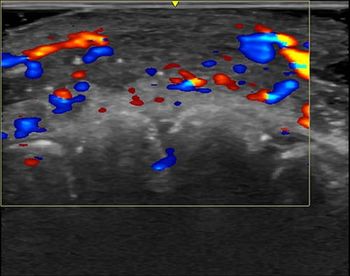
Transvaginal Ultrasound or MRI: Which is More Effective in Evaluating Endometrial Cancer?
In a new study looking at pre-operative assessment of low-grade endometrial cancer, researchers found that while magnetic resonance imaging (MRI) had 20 percent higher specificity than transvaginal ultrasound for deep myometrial invasion, there was no difference in sensitivity.
Does transvaginal ultrasound provide sufficient preoperative imaging for women with low-grade endometrial cancer?
That is the question researchers sought to answer in a newly published study in
The study of 259 patients with biopsy-confirmed low-grade endometrial cancer revealed an 88 percent specificity for deep myometrial invasion (MI) in comparison to 68 percent for TVUS. The authors also noted a 96 percent specificity on MRI for cervical stroma infiltration (CSI) in comparison to 90 percent for TVUS. However, there was no significant difference in sensitivity between MRI and TVUS for either MI (73 percent for MRI vs. 68 percent for TVUS) or CSI (41 percent for MRI vs 32 percent for TVUS), according to the study. In the assessment of MI, the researchers also noted no significant differences in negative predictive value between MRI and TVUS.1
“It is possible that TVUS, even though having lower accuracy, may not perform worse in predicting the absence of deep MI and of CSI than MRI, and therefore may be a good enough test to identify patients with a good prognosis who will not benefit from the extended surgery and its associated risks,” wrote Henrik Leonhardt, M.D., Ph.D., who is affiliated with the Department of Radiology at Sahlgrenska University Hospital in Gothenburg, Sweden, and colleagues.
The study authors noted that patients with high-grade endometrial cancer were excluded from the study as the prevalence of deep MI or CSI does not affect subsequent procedure selection for pelvic or para-aortic lymphadenopathy. However, preoperative imaging to clarify MI or CSI involvement may alter the extent of surgery for patients with low-grade endometrial cancer, according to Leonhardt and colleagues.
While they acknowledged an increased number of false positives due to overestimations of depth in the assessment of deep MI with TVUS, the researchers pointed out that TVUS and MRI had relatively similar capabilities of identifying deep MI.
“If higher rates of over-staging preoperatively are accepted, TVUS can identify almost as many of the cases with true deep MI as MRI and may be used as a first-line imaging technique, sorting out straightforward cases, with MRI as a second-line technique,” added Leonhardt and colleagues.
In regard to study limitations, the study authors noted that TVUS assessments were performed by 32 gynecologists who received short TVUS training whereas two radiologists assessed MRIs. However, Leonhardt and colleagues said this reflects clinical practice with final MRI reports coming from a few radiologists in a multidisciplinary setting and ultrasound results coming from initial gynecological exams. The researchers also acknowledged a lack of comparison for assessment of pelvic or para-aortic lymph nodes, but noted that in lieu of enlarged metastatic lymph nodes, overall imaging has poor results.
References
1. Palmer M, Akeeson A, Marcickiewicz J, et al. Accuracy of transvaginal ultrasound versus MRI in the preoperative diagnostics of low-grade endometrial cancer (PODEC) study: a prospective multicentre study. Clin Radiol. 2022 Oct 18; S0009-9260(22)00662-6. doi: 10.1016/j.crad.2022.09.118. Online ahead of print.
2. Sung H, Ferlay J, Siegel RL, et al. Global cancer statistics 2020: GLOBOCAN estimates of incidence and mortality worldwide for 36 cancers in 185 countries. CA Cancer J Clin. 2021;71:209-249.
Newsletter
Stay at the forefront of radiology with the Diagnostic Imaging newsletter, delivering the latest news, clinical insights, and imaging advancements for today’s radiologists.




























